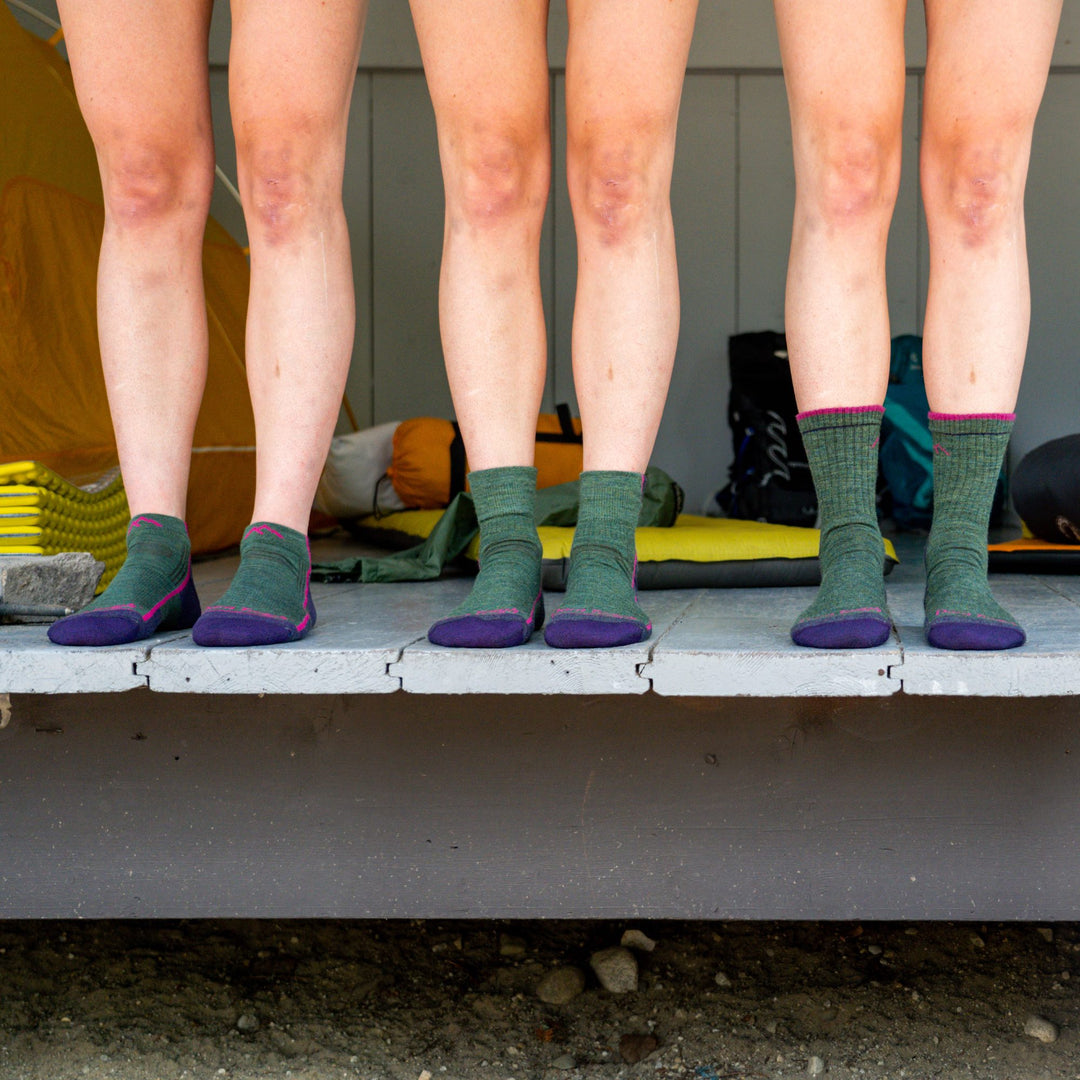How to Choose the Right Hiking Socks

My name is Owen and I work in Product Design and Development at Darn Tough. Some of you may know me Sir Owen VanGrizzle, Duke of Beartown, on the trail.
Like many Darn Tough wearers, I was first introduced to the brand when prepping for an ambitious hiking trip, mine being my first thru hike of Vermont’s Long Trail in 2010.
Love at First Trek
My local gear shop in Burlington, VT, assured me I should be wearing nothing else but Darn Tough socks for 4 reasons: superior comfort, bomb-proof durability, American-made quality, and a Lifetime Warranty to back it all up.
It was love at first trek, and I quickly started converting my sock drawer over to all Darn Tough socks and eyeing job openings at the company. Since that first wear, I’ve put them through the ringer of several other long ventures, including a thru hike of the Appalachian Trail in 2017. On that hike I only used TWO PAIRS for the entire 2189 miles. I still have those two pairs and wear them today.

As the Product Line Manager for Darn Tough, my role is to assist in continuing to make the best hiking socks out there today. But what makes them so good? And, with dozens of styles and designs to choose from, how does one pick the right pair to fit their specific needs?
In this post, I’ll guide you through how to choose hiking socks for your next hike, whether that’s a quick jaunt to your favorite local spot, or a several-thousand-mile-long trek.
Hike-Focused Features
A mantra I hold dear: You can have the best, most technical hiking footwear in the world, but your feet are not going to be happy if you are wearing a crappy pair of socks. If you’ve read my past post on How to Choose the Right Socks, this may sound familiar. I repeat the statement once again because it’s true for hikers. There's a reason you should wear hiking socks, not regular socks.
Knowing what socks to wear with hiking boots is an important decision. Hiking footwear needs to be part of a larger system, with socks playing as important a role as your boots or shoes.
And once the socks are on your feet and a part of this system, you should not notice them. There is nothing worse than being miles away from your destination and feeling every step. The right socks will help your feet feel better for longer, so you can walk on clouds, so to speak, without feeling the rocks and roots.

Designed with all hikers in mind, every sock in Darn Tough’s hiking collection includes basic features for any outdoor adventure. They include:
- Cushioned Comfort (for long miles)
- Superior Durability (for years of use)
- Performance Fit (no blisters!)
- Moisture Management (for help with sweaty feet)
- Thermoregulation (for any weather)
- True Seamless™ Toe (for that good, smooth feel)
Why Merino Wool?
Before I get into the specifics of each point above, it is important to touch on one of the key contributors to superior hiking socks: Merino Wool. One thing we like to say at Darn Tough is sheep have been hiking in Merino Wool for 10,000 years. You can’t beat that track record, or should I say “Trek” record...?
Other Darn Tough bloggers touch on this amazing natural fiber in greater depth, but I will mention the vital, natural components bring to the sock. They include natural softness, durability, thermoregulation, moisture wickability, fire retardation, and odor resistance; all properties that make great hiking socks.

Oh, and I should mention that all these properties work even when the wool is wet. Merino Wool ain’t your granddaddy’s itchy old rag wool. This is the real deal.
A few hiking styles are knit completely with synthetic materials, namely with Coolmax® fibers instead of Merino. Coolmax synthetic fibers are vegan and packed full of tech that imitates the properties of Merino. While they are good fibers, we mostly knit them for folks who cannot wear wool. That said, your Coolmax socks will do the job for you on the trail too.
Cushioned Comfort
All Darn Tough hiking socks have cushioning, in one of two forms. Cushioning is created by knitting Terry Loops, and it offers impact protection, shock absorption, and more Merino Wool (or Coolmax) to keep your feet happy mile after mile with thermoregulation, sweat wicking properties, and extra comfort.

Within the hike line, there are two types of cushioning, best defined as follows:
- Cushion: Terry Loops are knit underfoot, around the toes, and behind the heel – all areas of the foot where hikers can experience friction and impact, for the perfect medium cushioning. Our Midweight Boot socks with Cushion also feature Targeted Cushioning in the leg, which act as a guard against laces and cuffs on higher and more rugged boots.
- Full Cushion: Whether you need more cushioning for warmth or year-round moisture management, Terry Loops in these socks run through the entire foot and leg, all the way up to the cuff. Some folks assume Full Cushion socks are only for warmth. Having hiked in our Full Cushion Boot Socks in 90+ degree heat, I can tell you this is NOT the case due to the thermoregulating and moisture-wicking properties of Merino. My feet felt great, and I get very sweaty feet…

Whether you choose Cushion or Full Cushion often comes down to preferences, the footwear you’re wearing, the weather, your personal foot sweat generation, and more things we’ll touch on throughout this post.
What if you don’t want Cushioning at all? I would recommend our lightweight Athletic or Tactical socks as a non-cushioned alternative. If you’re unsure, I’d recommend starting in our hike collection, as those are guaranteed to have the features you need for hiking.
Superior Durability
Hikers need socks that do not quit and will perform for your entire outing, and then some. Durability starts with good materials. We only use premium Merino and high-quality spandex and nylon for reinforcement.
Next, high-density knitting with fine-gauge needles means a better fit and more toughness. Ensuring good materials and a tightknit, Darn Tough Hiking socks are then reinforced under foot, around the toe, and behind the heel in common friction and impact zones.

All our socks, whether designed for hiking or not, are backed up by our unconditional lifetime guarantee. You can’t have a warranty like that if your socks easily get holes.
To further ensure your socks last a lifetime, make sure you have a good fit to reduce bunching and sliding, which we’ll talk about next. Additionally, proper care is key to ensuring socks last even longer.
Performance Fit
Hikers want no bunching, no blisters or hot spots, and for their socks to act as one system with their foot and boot or shoe. Darn Tough Hiking socks, with their elastic-supported leg and foot arch and high-density knit, stay right where you want them for their entire journey.

Well-fitting socks reduce foot fatigue, help prevent blisters (no liner socks needed), and increase long-term durability as well. Make sure to check our size chart to verify you’re getting the right size for your foot.
Moisture Management & Odor Resistance
I told you earlier I have especially sweaty feet. If you missed that part, I say it here again because it’s part of the reason I choose Darn Tough every day.
Through performance Merino (or Coolmax), Terry Cushioning, and added mesh zones like those in our Light Hikers, Darn Tough Hiking socks wick sweat away from your feet, keeping them more comfortable for longer. Cotton socks, on the other hand, will collect the sweat and feel heavy and gross. Again, sheep have been hiking in wool for thousands of years in all climates.

Thicker socks do not necessarily translate to your feet feeling too hot, even in warm weather. I have coworkers who wear Full Cushion Mountaineering socks year-round, whether hiking or not, because they like how the additional wool and extra cushioning help manage moisture. Personally, my sweaty feet are why I always wear Cushioned socks.
It’s worth mentioning the natural odor resistant properties of Merino Wool, too. As an example, a Merino shirt I wore for 4 months straight on the Appalachian Trail still smells fine, while a synthetic shirt I wore for only one week on another backpacking trip stinks every time I wear it now.
Thermoregulation
I wore the same two pairs of socks for the entire Appalachian Trail.
My first week in March 2017 in the Georgian Mountains brought snow and 15-degree nights. Late June coming over Mount Greylock in Massachusetts, I drank 6 liters of water as the 97-degree humidity had me sweating buckets.

Through it all, my feet felt fine with the same Midweight Micro Crew socks. This was due to natural Merino Wool thermoregulation and breathability, keeping my feet warm in the cold and cool in the heat.
For this reason, I also wore the same Merino t-shirt the entire journey. That shirt has holes down the back from my pack straps. The socks held up.
True Seamless™ Toe
This is the feature most people forget because they don’t notice it (that’s a good thing!).
Socks are knit as a foot-and-leg-shaped tube and the toe end needs to be closed somehow. Darn Tough uses a looping mechanism during knitting with no seaming for a flat, smooth, invisible feel.
Pairing Socks with Footwear: Choosing the Height & Weight
With a basic understanding of the features in every Darn Tough Hiking sock, we’re ready to talk through the different choices in our Hike collection.
Hiking Footwear
First, let’s consider the footwear you plan on wearing. You will likely choose footwear based on anticipated terrain, the weather, your support and weight needs, and other preferences.
Some hikers thru hike in trail runners, some use a classic boot. Some like low shoes, while others like higher hiking boots. Again, preference.
Personally, I hiked 280 miles of the Appalachian Trail in road running sneakers (I needed new shoes FAST when my hiking shoes busted and the sneakers were all I could find in a small town. But that’s beside the point).

Whatever method you use to pick your shoes or boots, you’ll want to pair them with the proper height, weight, and cushioning in your sock. Some of this, of course, is preference. For example, my best friend and I wear the same model trail running shoe. He pairs it with a Lightweight with Cushion Quarter sock, while I wear a Midweight with Cushion Micro Crew.

With footwear in mind, let’s discuss different heights and weights.
Hiking Sock Heights

The height of your footwear dictates the minimum sock height you’ll wear. I recommend you choose hiking socks that come up at least as high as the top of your boot or shoe, if not higher, so you have full coverage between your ankle/leg and the boot to reduce hot spots from friction.
Even when wearing low shoes though, I personally like higher socks to cover my ankles and lower legs to protect from debris, rocks, pokey-sticks, bugs, and snakes (just kidding! Legally I must tell you not to rely on Darn Tough socks to protect against snake bites).
I also often wear gaiters and like the sock between the gaiter and my ankle. Some hikers want the minimum amount of sock possible while still high-enough to cover the foot and ankle from their shoe or boot. That’s cool too.
Darn Tough Hiking socks come in 5 heights: No Show, Quarter, Micro Crew, Boot, and Over-the-Calf.
-
No Show Light Hikers are a great pairing with trail runners or hiking shoes if you want the least amount of sock possible while still having all the Hike Sock features I discuss above. They come about 3.5 inches above the heel.

-
Quarter socks come about 5.5 inches above the heel. These are great for ankle or “mid” lowcut hiking footwear.

-
Micro Crews (my personal favorite height for hiking and most other activities) pair nicely with a 6 or 8-inch boot or anything lower. Enough to cover the ankle, but not too much sock!

-
Boot sock height has you covered in 10-inch boots or lower.

- Over-The-Calf socks (aka our Mountaineering socks) are great socks for cold-weather expeditions in taller boots.
Hiking Sock Weights
Darn Tough Socks come in 3 yarn weights: Lightweight, Midweight, and Heavyweight. This yarn is then paired with a Cushion or Full Cushion structure (see above under “Cushioned Comfort”) for every combination we think a hiker might need.
-
Lightweight: Lightweight Hiking socks are great for spring or summer climates. They have a close, breathable fit that keeps your feet cool without sacrificing performance. This weight is my go-to everyday sock weight and my preferred summer hiking sock. I love hiking in the U.S. southwest, and Lightweight Darn Tough socks are great for that desert heat or humid New England summer days. All Lightweight Darn Toughs have Cushion under foot, around the toe, and behind the heel. Our “Light Hiker” collection also includes performance mesh for increased moisture management.

-
Midweight: Midweight socks are ideal for year-round activities and come in either Cushion or Full Cushion models. As mentioned earlier, I hiked the entire Appalachian Trail in two pairs of our Midweight with Cushion socks, with weather ranging from 15-97 degrees Fahrenheit. Midweight socks offer thermoregulating insulation, protect your feet from impact, and wick away moisture. Great for most hiking efforts! Many wearers pair our Full Cushion Boots socks with winter hiking boots too.

- Heavyweight: Our Mountaineering socks are our heaviest, burliest hike socks and are built for rugged cold adventures or winter hiking socks. This weight only comes in Full Cushion, which you’ll want for extreme cold when mountaineering or ice climbing.
Other Hike Sock Features
Some Darn Tough Hiking socks include additional tech features for additional performance, including Mesh and Ribbed Knit legs.
- Mesh channels moisture away from your feet, further aiding the natural moisture-wicking properties of Merino Wool. Our Light Hiker collection has performance mesh built into the top of the foot to help your keep feet dry and cool.
- Ribbed Knitting includes the addition of extra elastic to create a vertical, supportive structure to help keep the leg of the sock where you want it and add some burliness too. Ribs vary in density and width throughout the hike line depending on preferred feel or style. For example, our Light Hiker collection features a low-profile 1x1 knit, for the lightest possible feel without sacrificing the tech.
- Cushioned Leg: All Midweight Hiking socks in the Boot height (whether designated Cushion or Full Cushion) feature cushioning in the leg of the sock for further protection from boot laces and cuffs. Lightweight Boot Socks do not have that cushioning in the leg.
Patterns & Colors
A question I get a lot is “What’s the difference between two socks of the same weight and height if they have different colors and patterns?” In short, the major differences are just that – patterns and colors.

Two socks of the same “chassis” (the combination of height, weight, cushioning, and tech) will fit the same, whether one is an understated charcoal colorway or the other has a flying outhouse or bear on it. We love to have fun in our Design Department so you can have fun on trail and show a little style. We offer a wide array of designs for many uses and personal styles.

One thing I will mention is that in addition to personal preference, some hikers choose lighter colored socks to help spot ticks or other bugs that could land on them. On the opposite end, some hikers choose darker socks so it isn’t as obvious they are dirty (but we all know they are when the rest of their legs are covered in mud!).
Other Uses for Hike Socks

Our Hiking socks are designed specifically for hiking, but that doesn’t mean you can’t use them for other activities. Since they’re designed to last thousands of miles on trail, they can perform for a lot of other activities too.
For instance, I love to run in them when cold weather or the trail calls for something thicker than our Ultra-Lightweight Run socks. I also wear them every day as my office socks and yard work and gardening socks.
They make great walking socks for a comfy padded option for walking off the trail (after all, isn’t hiking just walking?). My wife also wears our Heavyweight socks as slippers around the house. We have some pretty colors and designs that are fun to show off too in town or other places off the trail.
Choosing the Best Hiking Socks
Choosing the best hiking socks comes down to considering your adventure, your footwear, and your specific needs and preferences around Height, Weight, Cushioning, and Style.
I hope you’ve learned something and are now equipped to find the ideal hiking socks for you. Hopefully you feel all-set now to browse our hiking socks for men or hiking socks for women.
Feel free to check out our Sock Finder or our men's hike and women's hike buyer's guides if you need a few recommendations. See you on trail!

About the Author
Owen (Sir Owen VanGrizzle on the trail) works in Product Design and Development at Darn Tough. He's a resident sock tester, having thru hiked the Appalachian Trail in 2017 and Vermont’s own Long Trail twice. Owen and his wife Anna are taking on the Continental Divide Trail in 2023. Off the trail, Owen serves on the Board of Directors for the Green Mountain Club, with the mission of making the outdoors of Vermont accessible to everyone.
This post was updated on 8/31/2023 and originally published on 3/29/2022.







